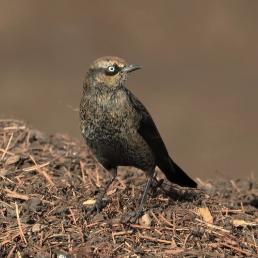

Join BirdNote tomorrow, November 30th!
Illustrator David Sibley and actor H. Jon Benjamin will face off in the bird illustration battle of the century during BirdNote's Year-end Celebration and Auction!
Every spring, birds like this Orchard Oriole and many others are arriving after a long flight across the Gulf of Mexico. Beginning in 1998, a handful of observers -- each assigned to a different oil platform -- began to monitor bird migration between March and May, as far as 100 miles out in the Gulf. Especially during storms, observers witness astonishing spectacles: tens of thousands of songbirds flying by at eye level, entire rivers of birds beating against the wind. These oil platforms, man-made islands, may offer temporary shelter — and possible dangers — for birds waiting out a storm. One observer counted 2,000 tiny warblers taking refuge on his platform!
BirdNote®
Trans-Gulf Migration and Oil Platforms
Written by Bob Sundstrom
This is BirdNote.
[Excited voices, and song of Orchard Oriole]
Every spring, people flock to the Gulf coast, from Texas to Alabama, to watch migrating birds arriving from the tropics. Like this Orchard Oriole, the birds are arriving after the long flight across the Gulf of Mexico. [Brief song of Orchard Oriole]
A few watch for these migrants even before they make landfall – as far as 100 miles out in the Gulf, from some of the 4,000 offshore oil platforms. [Sound of waves, wind] Beginning in 1998, a handful of observers – each assigned to a different platform – began to monitor bird migration between March and May.
Radar had already proven beyond doubt that millions of birds fly across the Gulf each spring. But few people had seen this first-hand, out of sight of land. [Pause]
Under clear skies, those watching see little, as birds travel thousands of feet up. But during storms, observers witness astonishing spectacles: tens of thousands of songbirds flying by at eye level, entire rivers of birds beating against the wind.
[Sound of waves, wind]
And oil platforms, man-made islands, offer shelter for birds waiting out a storm. One observer counted 2,000 tiny warblers taking refuge on his platform!*
Birdwatching from oil platforms has added to what we know about migration. [And it has rewarded a hardy few with the birding experience of a lifetime.]
[Sound of waves, wind]
Today’s show brought to you by The Bobolink Foundation. For BirdNote, I’m Michael Stein.
###
Bird sounds provided by The Macaulay Library of Natural Sounds at the Cornell Lab of Ornithology, Ithaca, New York. Orchard Oriole 40705 recorded by G.F. Budney.
Waves recorded on the Gulf by Kessler Productions; birdwatchers by C. Peterson.
Producer: John Kessler
Executive Producer: Chris Peterson
© 2014 Tune In to Nature.org May 2014 Narrator: Michael Stein
ID# migration-13-2012-05-04 migration-13
* There are some problems with oil platforms in the gulf - lighting, which may be dangerous to migratory birds for different reasons, etc. Read more at "Living on Earth" http://www.loe.org/shows/segments.html?programID=12-P13-00001&segmentID… . Sharks are another problem: http://www.wired.com/wiredscience/2012/01/birds-sharks-oil-platforms/&n…;
There always seems to be more to the story.





